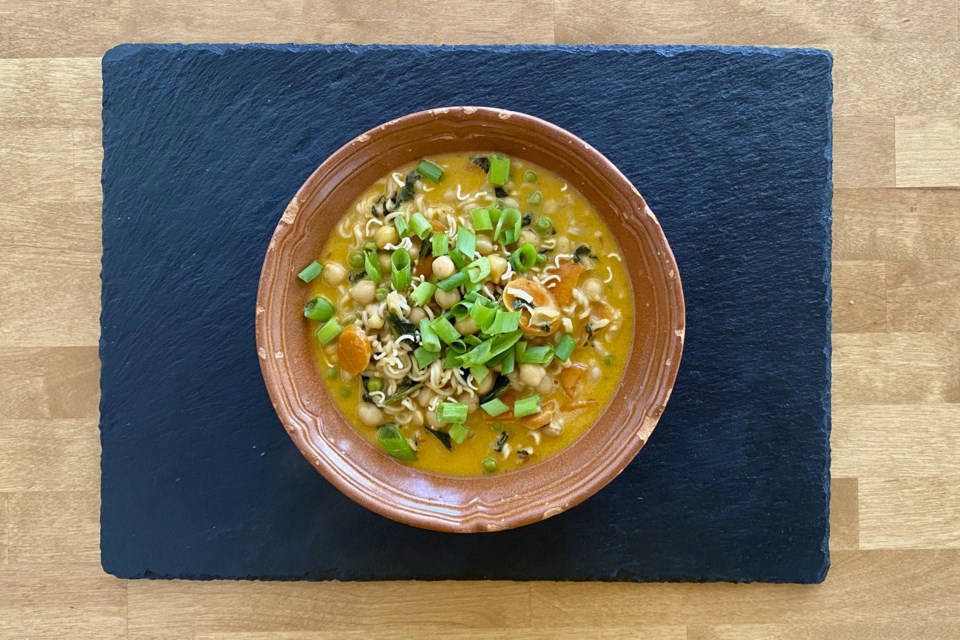To get a sense of Margaret Eby’s new book, “You Gotta Eat: Real-Life Strategies for Feeding Yourself When Cooking Feels Impossible,” flip to the section called “Anything’s a sandwich if you’re not a coward.”
The only requirement, she writes, is “some kind of bread or bread-like substance in order to keep the filling bounty under control. But basically, that’s where it ends.”
What follows is a series of comical treatises on combinations ranging from straightforward, such as avocado and tomato paste, to what she admits sounds weird, like canned pineapple and mayo.
Throughout the book, pantry puns are mixed in with helpful tips on how to get dinner on the table when you’re overwhelmed with work or the holidays, or simply depressed.
“It’s meant to kind of be like a kitchen pep talk, as well as something that gives you ideas for when you’re in that moment and you’re like, ‘Oh my God, I have to make dinner again,’” said Reby, who went to culinary school and spent years behind the scenes at glossy food publications.
For when the average recipe feels too complicated
A few years ago, during a dark period of pandemic malaise, she realized she and her coworkers almost never cooked the kind of multistep recipes they were selling. In the test kitchen at work, slick video and images of high-minded dishes were often the goal. For lunch, they might eat a microwave burrito.
At home, she often opened a package of ramen and dressed it up with whatever happened to be in the fridge, if that.
The realization led to this illustrated book, which is more of a guide to better ways of raiding the cupboard than a traditional cookbook. Besides recipes, there are also “roll your own” sections intended to let dice make decisions about what ingredients to include in bean salads, canapés, smoothies and casseroles.
“Dice do not carry the force of law,” she said.
She also makes the most of the freezer aisle. Crispy gnocchi or fried dumplings can be basic or borderline elaborate. Bagged vegetables turn college-age comfort food into a relatively balanced meal for working adults.
Leftover greens and herbs become savory sauces to make a utilitarian meal feel like an indulgence. A two-ingredient “emergency cake” involves self-rising flour, ice cream and a microwave.
No showstoppers required
For “curry in a hurry,” Eby draws inspiration from khao soi, a Northern Thai recipe for a spicy curried noodle soup. It’s a good example of her flexible recipe templates, which offer a direction without any pressure to produce a showstopper.
“Omit the noodles and serve it over rice, substitute meat for the chickpeas, use fresh vegetables if you have them, simmer some garlic and ginger with the curry powder,” she writes. “Throw cilantro on top at the end. Whatever you want to do.”
Whatever that is, it’s still dinner, and it will still be tasty.
“What I’m pushing back on with the book is this idea that every meal has to be this gorgeous, Instagram-perfect event,” she said. “There’s not a correct way for you to cook.”
___
Sort-of Khao Soi from “You Gotta Eat,” by Margaret Reby
Serves 2-4
1 tablespoon neutral oil, like canola
2 tablespoons curry powder or curry paste (Thai red or massaman curry paste works great)
1 15.5-ounce can chickpeas, drained
1 12- or 16-ounce bag frozen vegetables
1 13.5-ounce can coconut milk
2 packets instant ramen noodles
Salt and pepper
1⁄2 teaspoon red pepper flakes (optional)
In a medium or large pot over medium heat, add the oil. Wait about a minute for it to get hot, and then add curry powder or paste and pepper flakes, if you’re using them. Stir the powder or paste into the oil and cook it until it starts smelling like curry, about 30 seconds to a minute. Stir the chickpeas and vegetables into the curry oil to distribute it a little bit.
Add the coconut milk, fill the can with water, and dump that in too. It’s fine if the vegetables aren’t totally submerged — they’ll still defrost and cook. Raise the heat to high until the mixture boils, then turn it down until it’s simmering. Add 1 1/2 bricks of ramen noodles, and bring it back up to a simmer. Cook for 2 minutes — take a vegetable out of the pot and carefully take a bite to make sure it’s cooked all the way through. Salt and pepper to taste.
Scoop the curry into bowls. Crumble some of it over the bowls, as a garnish. If you have it, add fresh cilantro.
___
EDITOR’S NOTE: Albert Stumm writes about food, travel and wellness. Find his work at https://www.albertstumm.com
___
For more AP food stories, go to https://apnews.com/hub/food-and-drink.
Albert Stumm, The Associated Press



